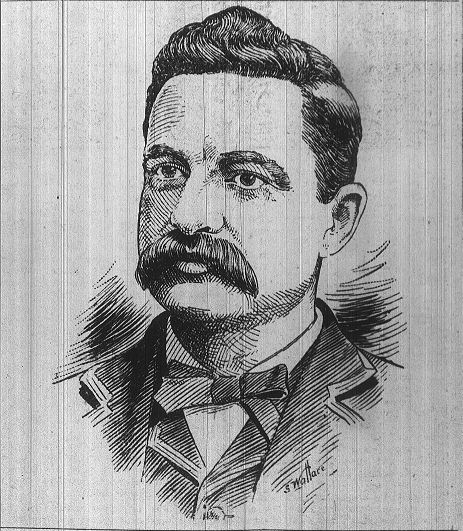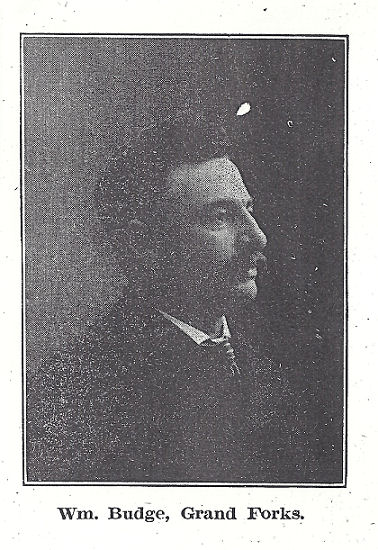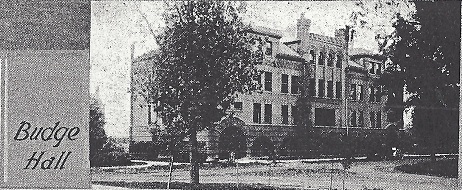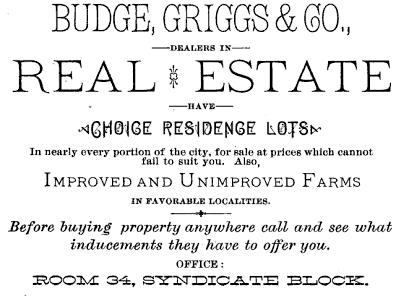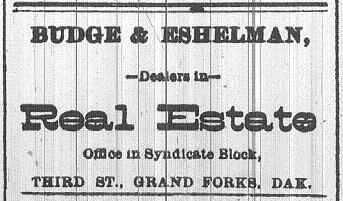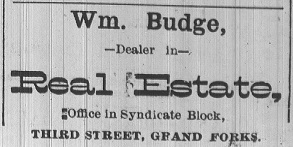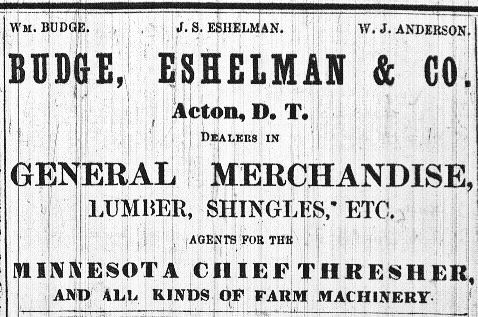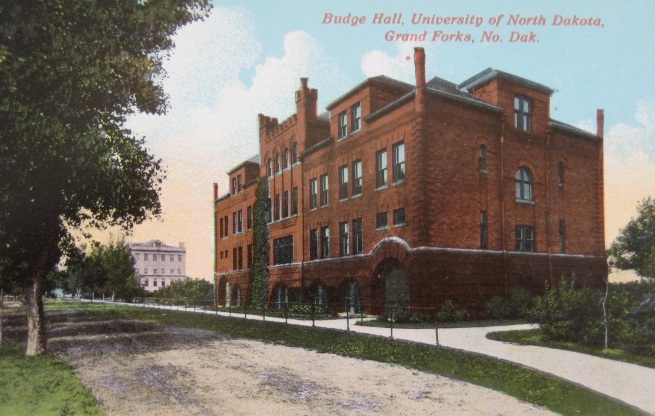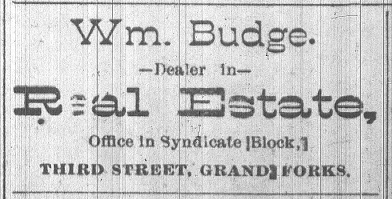William Budge was born in Scotland on October 11, 1852.
The 1880 United States census showed Jane Budge (age 66, born in Scotland) living in Grand Forks, Dakota Territory. Her sons John (age 29, carpenter), William (age 27, merchant), George (age 25, druggist), and Harry (age 22, blacksmith) also live in Grand Forks.
The 1885 Dakota Territory census showed William Budge (age 32, banker, born in Scotland) living in Grand Forks, Dakota Territory.
Page 728. WILLIAM BUDGE, who is closely identified with real estate matters at Grand Forks, North Dakota, deserves especial mention in a volume devoted to the prominent men of the Red River Valley. He has been closely connected with the history of this region since its earliest settlement, and,
Page 729. associated with Captain Griggs in many important enterprises, has done a great deal to aid in the growth and development of Grand Forks and vicinity. A man of wide experience, energetic, enterprising and liberal, no man has done more to promote the general welfare, and his name is indissolubly associated with the history of the valley. A man of high character and the strictest integrity, his word is as good as a bond, and he is highly esteemed both as a business man and an exemplary citizen. (Illustrated Album of Biography of the Famous Valley of the Red River of the North and the Park Region, Alden, Ogle & Company, Chicago, 1889)
Author Louis Geiger labeled William Budge “The Rockefeller of the University of North Dakota.”
Wm. Budge went on another hunting expedition yesterday, Turtle Mountains being his destination. (Grand Forks Daily Herald, Tuesday Morning, August 25, 1891, Volume XX, Number 239, Page 5)
Wm. Budge’s residence in the Red River Valley dates from May, 1870. In the spring of 1869 he left the home of his childhood in the Orkney Islands, Scotland, to serve the Hudson Bay Company. He landed at York Factory, on Hudson Bay in August, 1869, and was immediately sent to the Saskatchewan river country, where he spent the following winter. Early in the spring of 1870, however, Mr. Budge decided that he had seen enough of that inhospitable region, and one evening when the chief factors and chief traders and postmasters and other official dignitaries of the Hudson Bay Company were quietly snoozing, Billy provided himself with a good supply of jerked buffalo meat, pemmican and gellup and “lit out” for the “land of the free and the home of the brave.” After a tramp of over 800 miles he reached Winnipeg, but as that community was in the throes of the Riel rebellion, besides being the haven of innumerable Hudson Bay Co. officials whom Billy was not anxious to interview at that time, he did not tarry there but a day or two. He continued his journey southward and about the first of June crossed the boundary line at Pembina where he was warmly welcomed by the writer of this sketch. The welcome was extremely cordial principally because Billy came provided with “grub” in the shape of flour and pemmican thus breaking a straight cat-fish diet that had prevailed at Hungry Point for some time previous. The luxury of “stir-about” or “bouyaw,” made of flour, water, jerked buffalo meat and cat-fish, was freely indulged in for several days, and Billy was voted the hero of the hour and duly installed as the fourth member of the “gang.” A year was spent in Pembina, where Mr. Budge assisted in making the first brick ever made in North Dakota. He also served an apprenticeship at cooking during the winter of ’70 and ’71, and no more palatable meats were served anywhere in the northwest than those prepared by Billy. In April, 1871, he located at Turtle River, near the present site of Manvel, where he resided four years. He then came to Grand Forks, entered into business, took up land near the embryo city, and is today one of its most influential, affluent and honored citizens. (Grand Forks Daily Herald, Friday Morning, December 11, 1891, Volume XXI, Number 35, Page 2)
Billy Budge was one of the star performers on that hand car Sunday (during the record Red River Flood of 1897), and received several jollies on it yesterday. (When the steamboat Ogemaw sank north of Grand Forks, the crew had to ride a hand car on the railroad back to Grand Forks) (Grand Forks Daily Herald, Tuesday, April 13, 1897, Page 1)
The 1900 United States census showed William Budge (age 47, farmer/postmaster, born in Scotland) married to Minnie (age 32, born in New York). The couple had a son, Alexander (age 8, born in North Dakota) and a daughter, Jean (age 2, born in North Dakota). The family resided in Grand Forks, North Dakota.
WILLIAM BUDGE, the efficient postmaster of Grand Forks, North Dakota, is a pioneer settler of that region. He was born in the north of Scotland, October 11, 1852. The parents of our subject, John and Jean (Budge) Budge, were natives of Scotland, and the father was a farmer and died in Scotland and the mother afterward emigrated to America, and died in this country. Our subject remained in his native place until he was sixteen years of age, and in 1869 came to Northwest territory, with the Hudson’s Bay Company, and was employed by that company one year in the Northwest territory. He went to Pembina, North Dakota, in 1870, and began work for W. C. Nash, in the brick yard and after the summer went to Turtle river, and there built a station for the stage company with George Winship, a sketch of whom appears elsewhere. They operated the place three seasons, and in 1874 he went to Grand Forks, and has since made his home in that city. He went to the Black Hills in 1876, and was engaged in freighting from Bismarck, and was thus engaged two years.
He started a store at Kelly’s Point, and conducted the same for some time, and then returned to Grand Forks and engaged in the real estate business. He was chairman of the county board in 1875, and in 1880 was appointed sheriff and resigned after six months’ service in that capacity. He has served as a member of the board of trustees of the State University (UND), and was appointed postmaster at Grand Forks in July, 1898. He also conducts a grain and commission business in Grand Forks and is well-to-do. He was one of the directors of the Citizens’ National Bank, and was president of the same for some time. He was also once interested in the First National Bank. Our subject was married in 1890 to Miss Minnie Grow, a native of New York. Two children have been born to Mr. and Mrs. Budge, who bear the names of Alexander and Jean. He was a member of the constitutional convention, and holds a membership in the Masonic fraternity, Knights of Pythias and Elks. He is a staunch Republican politically. (Compendium of History and Biography of North Dakota, Geo. A. Ogle & Co., Chicago, 1900, Page 173)
Wm. Budge is a native of the island of South Ronaldsay, the southernmost of the Orkneys, Scotland, and came across the ocean to this country in the year 1869. He came in by way of Hudson bay and states that the method of travel at that time between York Factory and Fort Garry was by the Hudson Bay company’s Mackinaw boats and Indian canoes. He remained in Manitoba for awhile, traveled west as far as the Rockies, which in those days was no railroad journey, and soon afterward he came to Pembina. (History of Grand Forks County, With Special Reference to the First Ten Years of Grand Forks City, H. V. Arnold, Larimore Pioneer, Larimore, North Dakota, 1900, Page 73)
Grand Forks Men Had Good Luck in the Buford Country. Grand Forks, N. D., Nov. 22. – The party of Grand Forks deer hunters which left this city about two weeks ago, consisting of George B. Winship, William Budge, A. F. Turner, E. C. Cooper, H. P. Ryan, W. F. Perry, Sam Overby and Sam Bowers, who officiated as cook, returned home yesterday morning, having killed fourteen deer. Every man killed his deer. A. F. Turner killed the largest number, three, and Winship carried off the prize for the largest deer. The party pitched tents near Buford, west of the Missouri river, and north of the Yellowstone, and from 6 o’clock each morning till late in the afternoon, beat the woods under the direction of A. F. Turner, who was captain of the hunt. On breaking camp, the fruits of the hunt were all but lost in an accident while crossing the Missouri river in a rowboat. The ferry had gone out of business for the season, and it was necessary to cross in a skiff. The deer were loaded in a boat, with Sam Bowers perched on top. In some manner he lost his balance, fell into the river and turned the boat bottom side up. Fortunately all the deer were recovered, as the water was shallow. (The Minneapolis Journal, Friday Evening, November 22, 1901, Page 17)
WILLIAM BUDGE. William Budge, or “Billy,” as he is more commonly termed, knows more of North Dakota history and can relate more personal experiences perhaps than any of the old pioneers. Mr. Budge was born in Bonny Scotland, and migrated as far north as Hudson’s bay in 1869, traveling inland as far as the Rocky mountains. In the spring of 1870 he arrived in North Dakota where he met Geo. B. Winship immediately after crossing the line. During his first summer here he was engaged in making brick for W. C. Nash of East Grand Forks, who then had the contract for constructing some government buildings at Pembina. Not long afterwards he came to Turtle river where he squatted on a claim, but being too young at that time to prove up the same he relinquished his rights, afterwards going to the Black Hills where he had expected to build up fame and fortune. Having a tender spot in his heart, however, for North Dakota and its people, he returned after an eighteen months’ stay. Prior to his western trip he had resigned his position as county commissioner, and subsequently was appointed sheriff of the county which position he also resigned. For a number of years he was engaged in the general mercantile business, and at all times was closely identified with the political and the business interests of the state. For ten years Mr. Budge has been a member of the state university board and one of the most active supporters of the institution. Last fall he was appointed postmaster of Grand Forks by President McKinley. Mr. Budge has always taken an active interest in local affairs and is well known throughout North Dakota and northern Minnesota. (Grand Forks Daily Herald, Tuesday Morning, June 27, 1899, Volume 18, Number 205, Page 37)
The 1910 United States census showed William Budge (age 55, farmer/fruit rancher, born in Scotland) married to Minnie (age 40, born in Iowa). The couple had a son, Alex (age 18, born in North Dakota) and a daughter, Jean (age 13, born in North Dakota). The family resided in Grand Forks, North Dakota.
Page 487. WINSHIP HOTEL – BUDGE’S TAVERN – AN ENTERTAINING STORY OF YE OLDEN TIMES IN NORTH DAKOTA. When Pembina was little, before Grand Forks, Fargo and Moorhead were born, George B. Winship strayed in from the south via Abercrombie, and Billy Budge from Scotland via Hudson’s Bay, and meeting at Pembina in 1871, where George was engaged as a clerk in the sutler’s store, they concluded to form a partnership and enter into business. They selected a point on the stage line between Grand Forks and Pembina known as Turtle River, where they erected a log cabin and put in a little stock of those things essential to life for man and beast and opened up a hotel. The old-timers all credit them with having kept an excellent stopping place, one of the best on the line, and both were popular and have since prospered in this world’s goods. Winship established the Grand Forks Herald, represented Grand Forks District in the State Senate several terms, and on his retirement went to California where he enjoys a fortune from the proceeds of well used opportunities in North Dakota.
William Budge was a member of the constitutional convention and also represented his district in the State Senate several terms, was the leading spirit in the establishment of the State University, and was one of its regents for several years, and postmaster at Grand Forks, moving to Medford, Ore., where he became one of the leading business men of Jackson County, and always the true and noble hearted man he was in the early days of North Dakota. The following, condensed from Clarence Webster’s story in the Chicago Inter Ocean in 1886, will be enjoyed by their friends:
“After erecting their cabin, which was the only human habitation in 1871 between Grand Forks and Pembina, unable to agree on the name for their place, as the story runs, they agreed to label it ‘Winship’s Hotel,’ so as to meet the view of those coming from the south and that ‘Budge’s Tavern’ should be the sign displayed for the observation of those coming from the north. They disagreed in many things but united in one, ‘We are not here for our helth,’ was to be conspicuously printed on a card to be hung on the wall over the fireplace. ‘God Bless Our Home,’ and others of that nature were not fashionable then. The early settlers were the practical sort of fellows, who believed in informing people just where they were at and what was expected of them. “Budge was an expert in turning the flapjacks while Winship was equally good as a valet de chambre at both house and barn, Budge assisting however between meals. Both were excellent collectors and usually insisted that there
Page 488. must be an understanding as to the pay before any of the supplies had been consumed. It is said they each warned the travelers not to pay the other, resulting in occasional loss on the grounds that it was unsafe to pay either. They had a monopoly and like all monopolies were independent and when there were any objections to paying $2 for flapjacks a la Budge and stable accommodations a la Winship the unfortunate objector was invited to read the card over the fireplace and move on. Sometimes Budge suggested that the man who objected to paying $1 for a white man’s mean could fill up on marsh hay at half price. “It sometimes happened that objections were made to the economical spelling of the word health in the sign upon the wall. If the kick was made to Budge he added a half to the bill for extras. If it was commented on before Winship, with great presence of mind he always remarked that the proofreader must have been drunk as usual when they went to press with it.
“Neither proposed to allow the other to get ahead of him. They made a nightly division of cash and had a definite understanding as to the division of labor. Each in turn was to build the fires, and in order that there might be no mistake they arranged a calendar and pasted it at the foot of the bed. Commencing with B. W. B., alternating with W. B. W., there were thirty sets of initials, representing each day in the month. When Winship had built the fire he rubbed out the last initial and Budge did the same when it came to his turn. The crossed letter always settled the question as to who was to get up next time and indicated the day of the month. “One morning Budge got up and built the fire canceling the B. It was a roaring fire, made especially for a temperature of 30 below. The frail chimney, built of sticks and mud, surmounted by a barrel, caught fire. Soon the fire spread until Winship’s end of the building was burning at a lively rate. Winship poked his elbow in Budge’s side, he having fallen asleep, who thinking a mule had kicked him, yelled, ‘Whoa.’ Another nudge partially awakened him, when Winship said, ‘Billy, she is afire again.’ Budge protested that he had spoiled the slickest dream he had ever had and that he would have had it all fixed in a minute more if he had been left alone, besides he didn’t see why he should be disturbed. He wanted to sleep.
“The fire is spreading,’ said Winship. ‘Better get up and put it out while you can do it easy. It is your turn to get up.’ “It ain’t my time to get up,’ said Budge. ‘The B. is crossed out.’ “It is your fire,’ said Winship, ‘you built it, you had better put it out. It’s getting too hot.’ “Budge insisted that the fire was Winship’s by right of discovery and he must take care of it. “Higher leaped the flames, closer and closer they came to the Scotchman, who was still insisting upon his rights to sleep undisturbed after building the fire. His own part of the shanty was ablaze. Coals were dropping down on the robes under which they had been sleeping. Winship drew the robe over his head. “Finally Budge proposed that they both get up. ‘That is reasonable,’ replied Winship. ‘Why didn’t you think of that before?’ “They both got out. Some of the bacon and other things were saved. (North Dakota History and People, Volume I, Clement A. Lounsberry, The S. J. Clarke Publishing Company, Chicago, 1917)
Doubtless the most potent influence in determining the location (of UND) was the personal influence of William Budge, another energetic Grand Forks “booster,” who owned most of the land between the city and the site (of UND) and who was naturally interested in the development of that part of the suburban district. “Billy Budge,” as he was familiarly known, was a canny Scotchman and a clever politician. He later did a great deal of work to help out the University at the time of the veto of the appropriations bill in 1895. In recognition of his services, the legislature made him a “life member” of the Board, and the Men’s dormitory built in 1899 was named in his honor. (The Quarterly Journal of the University of North Dakota, Volume 13, 1922-1923, Published by the University, Page 363)
Erecting the new building (Old Main at UND) involved many problems. Among these was the question of living accommodations for the workmen. There were no boarding houses nearer than those in the heart of the city over two miles away. The contractor finally persuaded Mrs. John M. Carroll to come out to take charge of a temporary establishment near the new building. “Billy” Budge’s original claim shanty stood there on the bank of the Coulee. This was cleaned up, a second story was built, and wings containing bunks and a dining hall were added. Mrs. Carroll had only recently come to Grand Forks from her home in Saratoga County, New York, but she had gained a reputation as a superior cook, and for over a year she ran the “boarding department” in the rehabilitated shack. (The Quarterly Journal of the University of North Dakota, Volume 13, 1922-1923, Published by the University, Page 364)
Coincident with the paralyzing effect of Governor Allen’s blue-penciling of the appropriation in 1895, Mr. William Budge, a devoted trustee and supporter of the University, prevented President Webster Merrifield from accepting the offer of the presidency of the University of Montana. Had President Merrifield accepted the Montana offer in 1895, he would have taken his entire faculty with him. In that event it is probable that the University of North Dakota, so far as the unit at Grand Forks was concerned, would have ceased to exist. While it is speculative it is probable that efforts to consolidate the unit at Grand Forks with the Agricultural College at Fargo would have been undertaken and would have succeeded. Under the leadership of Mr. Budge and President Merrifield, a vigorous campaign for private financial support was initiated. The necessary funds for a restricted and limited budget were subscribed by citizens of the State and Grand Forks. (The Quarterly Journal of the University of North Dakota, Volume 13, 1922-1923, Published by the University, Page 394)
The 1920 United States census showed William Budge (age 67, rancher/hog farmer, born in Scotland) married to Minnie (age 51, born in New York). The couple still had a daughter, Jean (age 22, born in North Dakota), living with them. The family resided in Berkeley, California.
The 1930 United States census showed William Budge (age 77, rancher from Oregon, born in Scotland) married to Minnie (age 62, born in New York). The couple still had a daughter, Jean (age 33, born in North Dakota), living with them. The family resided in Oakland, California.
Early Settler of City Dies in California. William Budge, pioneer of Grand Forks, member of the North Dakota constitutional convention, and former postmaster of Grand Forks, died Saturday morning (July 9, 1938) in Oakland, Calif. He was 85 years old. He was the last survivor of a family of four brothers who came to Canada in the sixties as employees of the Hudson’s Bay Co. His brothers, George, Harry and John Budge are buried in Grand Forks. Born in the Orkney Islands off the coast of Scotland, October 11, 1852, Mr. Budge came to North Dakota in 1870 and was first located at Pembina. A year later he and George Winship, founder of the Grand Forks Herald, built a stage station on the Turtle river. He was there for three years before moving to Grand Forks. Mr. Budge went to the Black Hills with an expedition from Grand Forks in 1876, and engaged in various enterprises and returned to Grand Forks. He served a short time as sheriff and was one of the early county commissioners here. He was one of the original trustees of the University and was appointed postmaster in 1898 serving for eight years. He was president of the Citizens National bank and interested in numerous other business enterprises in the city before leaving for Oakland about 1910. Married in 1890 to Miss Minnie Grow of New York, she with a son, Alexander of Honolulu, and a daughter, Jean of Oakland, survive. Mr. Budge was a member of the Masonic lodge and the Kem temple of the Mystic Shrine. Funeral rites will be Monday in Berkeley. (Grand Forks Herald, Sunday Morning, July 10, 1938, Volume 57, Number 216, Page 8).
William Budge. Few names loom larger in the early lore of Grand Forks than that of William Budge, who died Saturday in Oakland, California, at the age of 85 years. His life in Grand Forks spanned the period of the transformation of a stretch of lonely prairie to the present city. He came to America from his native Orkney islands for the Hudson’s Bay Co., and wandered south until he met George Winship, founder of the Herald. These two men built a tavern on the Turtle river in 1871. It was “the only human habitation then between Grand Forks and Pembina.” Travelers from the north saw a sign proclaiming the log shack as Winship’s hotel. Those from the south read that it was Budge’s tavern. Perhaps no hotel has had more stories told of it than that Budge and Winship stage station. The two men came to Grand Forks a short time later. Theirs was among the most prominent roles in the development of the city. William Budge was one of the donors of land upon which the University stands. He was one of the early trustees of the institution and Budge hall was named in his honor. In 1876 William Budge was one of that party of 11 that left Grand Forks for the Black Hills. D. M. Holmes and J. S. Eshelman were also in the party. The story of its trek overland, its brushes with the Indians, its hardships and its courage is one of the epics of early North Dakota. Two years later, he was back in Grand Forks, and for 32 years his name was a common one in civic and business matters of this city. He then went to the coast to spend his retiring years in a quiet, so different to his pioneering in Manitoba and North Dakota.
With the passing of Mr. Budge, one of the last remaining links with that time when there was no Grand Forks disappeared. He did much for Grand Forks. He left his mark upon the early history and the development of the city. He was one of the pioneers, whose like we shall see no more, because there will never be another time in which such qualities as they had will be necessary. He was one of the first to come into this territory to build an island empire for thousands who would come later to find homes. His was a full life. It began in a world of adventure in a land of hostile nature and natives. Then came a period of community activity, in which the city and district derived much from him. This followed by the peace of his retired years, surrounded by friends. There are but few now who remember him as a young pioneer, but whenever the early history of Grand Forks is scanned, frequently will appear the name of William Budge. (Grand Forks Herald, Tuesday Morning, July 12, 1938, Volume 57, Number 217, Page 4)
